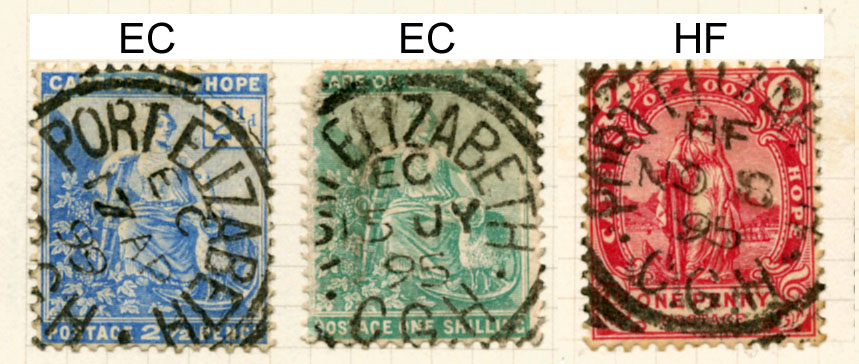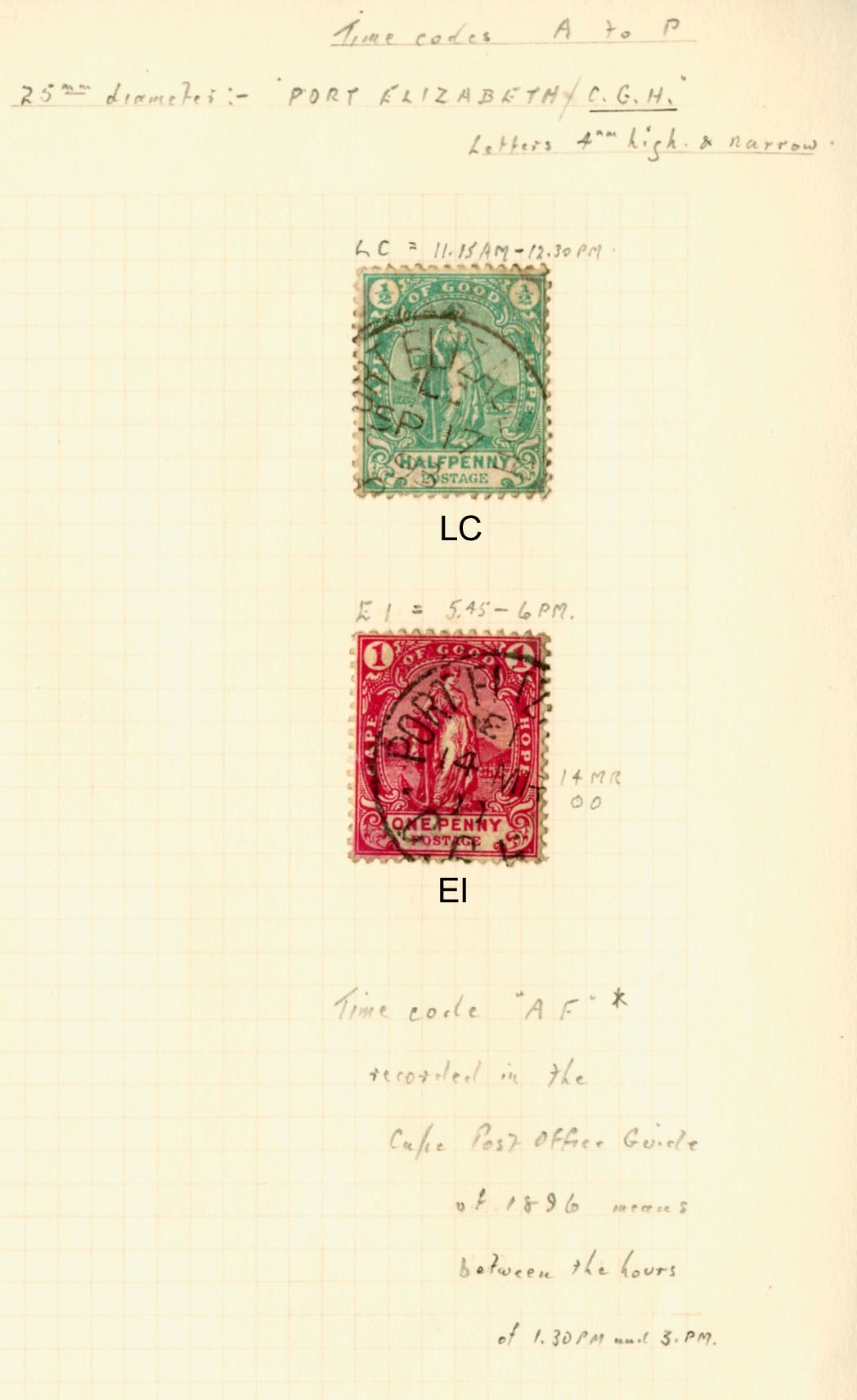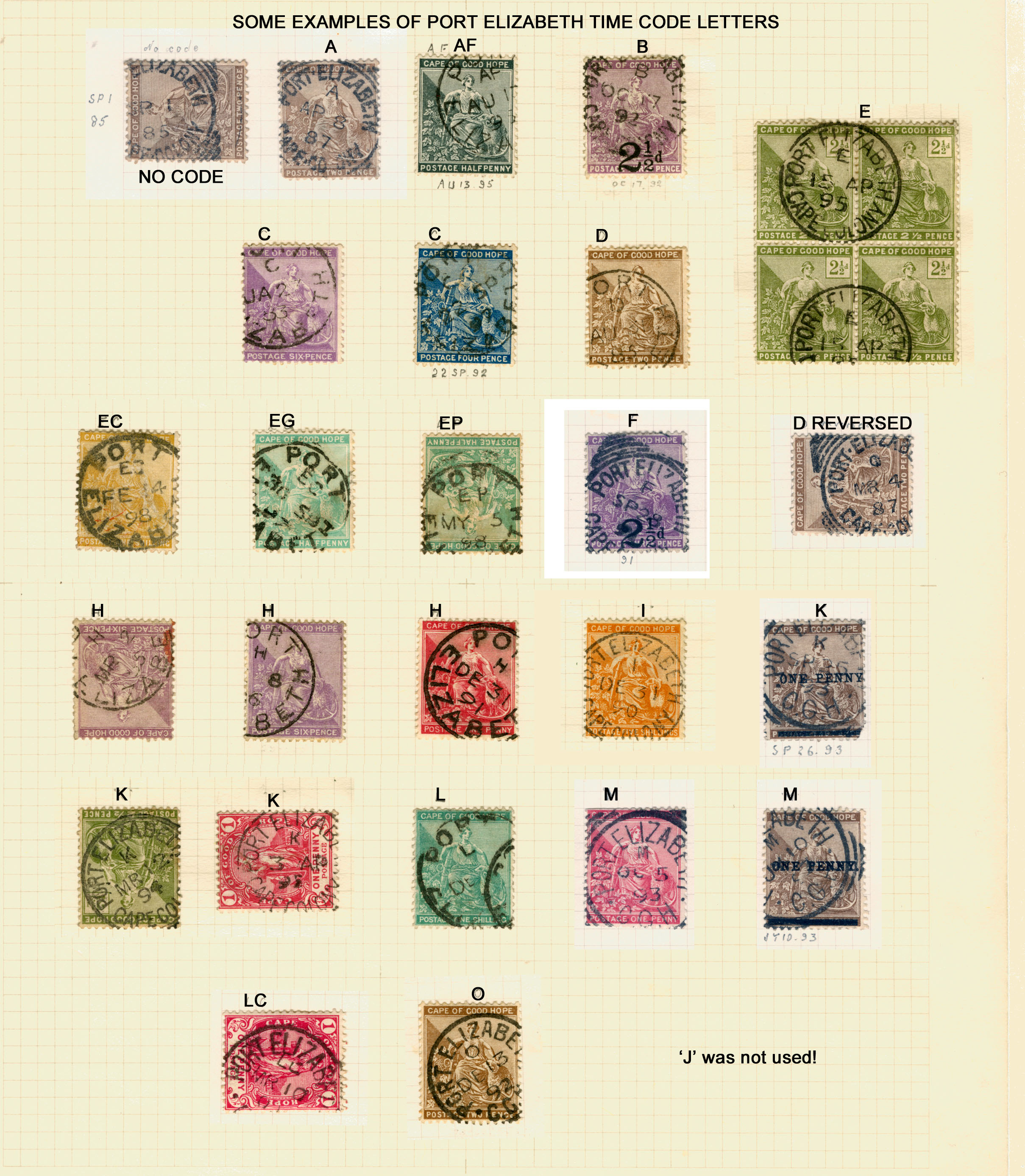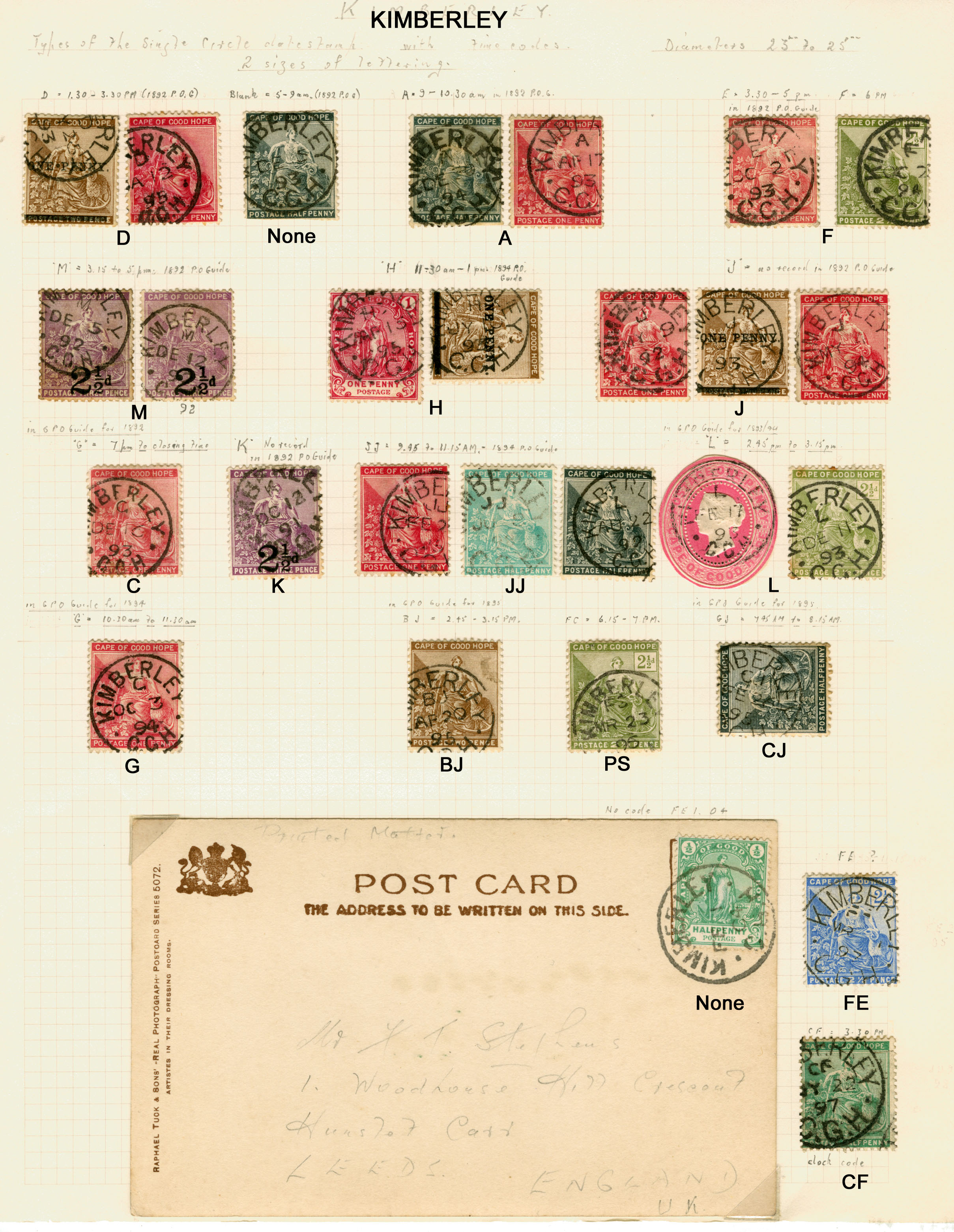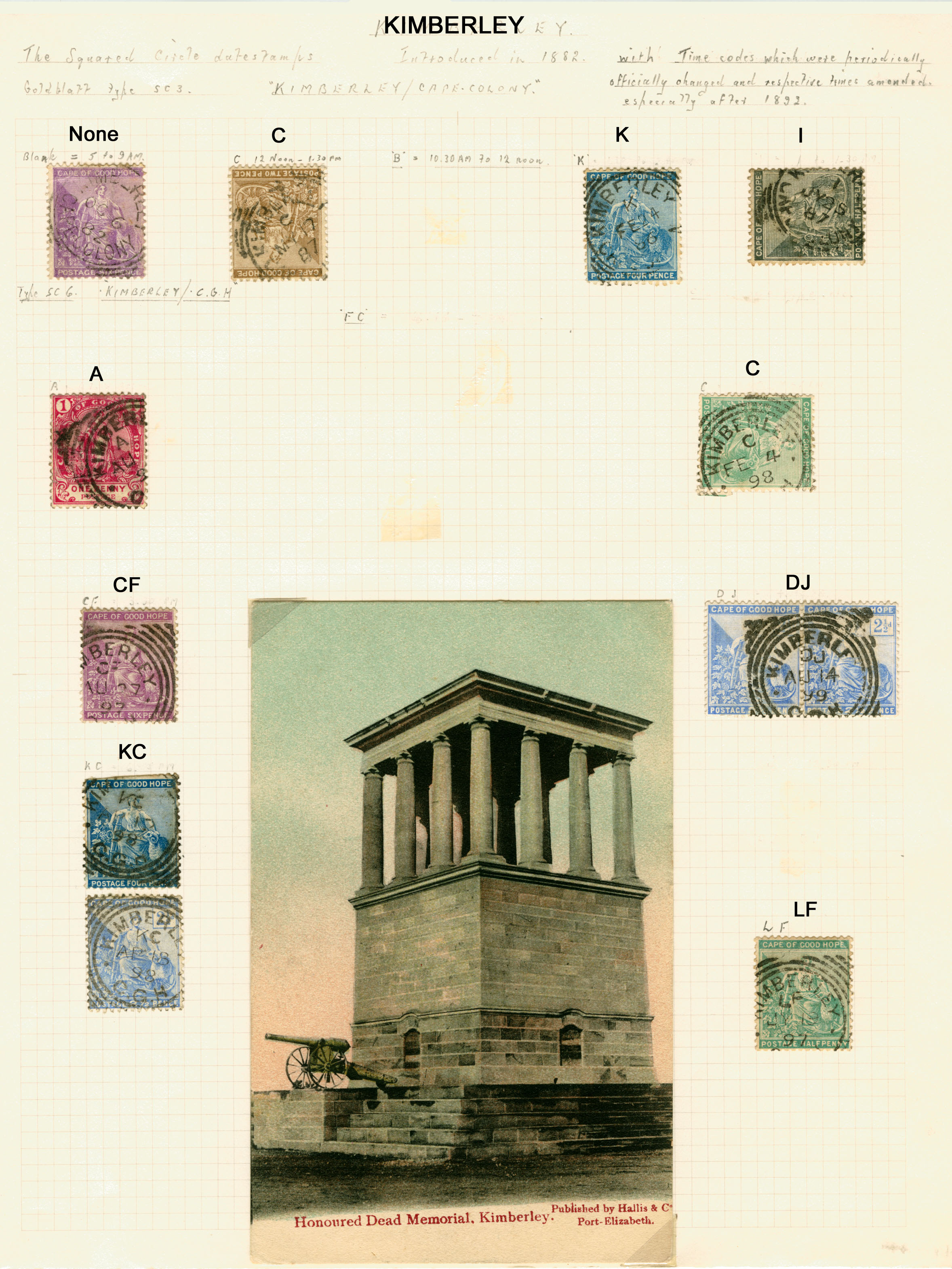CoGH Double Letter Time Codes
Quote from Steve on May 26, 2023, 1:06 pmThis topic came up in the the post on Simon Kelly's intriguing Hooded Circular datestamp display. I have decided to start a new topic on the subject here as I do not want to go too far off-topic in the Hooded Circular datestamp forum.
Simon did ask the South African Collectors' Society for advice on the subject of double letter time codes but received no reply, as far as I know. After posting his Hooded Circular datestamp display on this site and starting a discussion about it numerous examples of double letter time codes came up with an explanation for their intended purpose.
This is a fascinating subject, a totally new field for me. Prior to Simon's query about double letter time codes their existence had passed me by. I imagined that the single example he provided as proof of their existence was a peculiar one-off act of mischief by a postal clerk. I could not have been more wrong. Worse, I had bought a small study of Cape postmarks from none other than Simon which was packed with postmarks on stamps showing double letter time codes. I had a trove of exactly this material sitting under my nose and was none the wiser for it.
As Yannis has pointed out double letter time codes were part of a detailed time coding system based on established British practice. As the Cape Colony Post Office took its the lead from Britain's GPO, this practice was implemented in the larger, more important post offices of the Cape Colony. Examples of these double letter time codes are found in Cape Town, Port Elizabeth and Kimberly during the 1890s and presumably elsewhere in the Cape. But where else?
This is where you come in. If among your displays, collection and accumulations you have examples of double time code letters in different combination, especially from towns other than Cape Town, PE and Kimberley, please share them with us. Below are some I found recently. This could be a whole new field of study on stamps for anyone not wanting to spend a lot of money on covers. I was lucky and got a head start because I bought quite unwittingly from Simon the remainders of a study of time code letters on Cape postmarks on stamps and a few postcards.
As you can see, the PE post office implemented the double letter time code across a variety of datestamps for quite some time. The Earliest Recorded / PE use that I have - and there are certainly going to be earlier examples - is from '15 JY 95' on a Squared Circle datestamp. They are also found on a variety of Single Circle datestamps, as well as the Hooded Circular datestamp. The Last Recorded / PE use I have is '17 AP 99', also on a Squared Circle datestamp. The examples I have suggest that they were in regular use during the mid to late 1890s.
This topic came up in the the post on Simon Kelly's intriguing Hooded Circular datestamp display. I have decided to start a new topic on the subject here as I do not want to go too far off-topic in the Hooded Circular datestamp forum.
Simon did ask the South African Collectors' Society for advice on the subject of double letter time codes but received no reply, as far as I know. After posting his Hooded Circular datestamp display on this site and starting a discussion about it numerous examples of double letter time codes came up with an explanation for their intended purpose.
This is a fascinating subject, a totally new field for me. Prior to Simon's query about double letter time codes their existence had passed me by. I imagined that the single example he provided as proof of their existence was a peculiar one-off act of mischief by a postal clerk. I could not have been more wrong. Worse, I had bought a small study of Cape postmarks from none other than Simon which was packed with postmarks on stamps showing double letter time codes. I had a trove of exactly this material sitting under my nose and was none the wiser for it.
As Yannis has pointed out double letter time codes were part of a detailed time coding system based on established British practice. As the Cape Colony Post Office took its the lead from Britain's GPO, this practice was implemented in the larger, more important post offices of the Cape Colony. Examples of these double letter time codes are found in Cape Town, Port Elizabeth and Kimberly during the 1890s and presumably elsewhere in the Cape. But where else?
This is where you come in. If among your displays, collection and accumulations you have examples of double time code letters in different combination, especially from towns other than Cape Town, PE and Kimberley, please share them with us. Below are some I found recently. This could be a whole new field of study on stamps for anyone not wanting to spend a lot of money on covers. I was lucky and got a head start because I bought quite unwittingly from Simon the remainders of a study of time code letters on Cape postmarks on stamps and a few postcards.
As you can see, the PE post office implemented the double letter time code across a variety of datestamps for quite some time. The Earliest Recorded / PE use that I have - and there are certainly going to be earlier examples - is from '15 JY 95' on a Squared Circle datestamp. They are also found on a variety of Single Circle datestamps, as well as the Hooded Circular datestamp. The Last Recorded / PE use I have is '17 AP 99', also on a Squared Circle datestamp. The examples I have suggest that they were in regular use during the mid to late 1890s.
Uploaded files:Quote from Steve on May 26, 2023, 1:34 pmThis advice is from Yannis which I have copied from Simon Kelly's Hooded Circular datestamp display.
"Here's a screen capture of some notes I have on my computer regarding time codes, for Kimberley though. I think at the time I probably copied them from Goldblatt, worth checking. As you will see a blank code is not an error of a missing time code but denotes a particular time. Placing the * on top or bottom of the postmark, might also have had some meaning at least for some Post Offices. If anyone can get hold of the Post Office Guide of 1896, it might clarify a lot of answers."
I attach a sheet showing examples of everyday single and double time code letters, as well an examples of none and an inverted letter, all from PE. This was cobbled together from several remaindered sheets using Cut&Paste.
This advice is from Yannis which I have copied from Simon Kelly's Hooded Circular datestamp display.
"Here's a screen capture of some notes I have on my computer regarding time codes, for Kimberley though. I think at the time I probably copied them from Goldblatt, worth checking. As you will see a blank code is not an error of a missing time code but denotes a particular time. Placing the * on top or bottom of the postmark, might also have had some meaning at least for some Post Offices. If anyone can get hold of the Post Office Guide of 1896, it might clarify a lot of answers."
I attach a sheet showing examples of everyday single and double time code letters, as well an examples of none and an inverted letter, all from PE. This was cobbled together from several remaindered sheets using Cut&Paste.
Uploaded files:Quote from Steve on May 28, 2023, 8:36 amHerewith some Kimberley double letter times codes on stamps from the same study above. I found some excellent other items, real gems, among this lot. Originally this would have been something to see as it was arranged by postmarks and was pretty comprehensive. The best bits had been picked out when I bought it but there was still enough for me to enjoy (and hopefully you too). You can see a decent Single Circle study sheet below that could be easily-filled. The Squared Circle sheet needs more work. Roll on a cold, dark winter's night!
I do not know who put this study together but I can sense a kindred spirit with a shared love of postal history.
Note: 'J' was used. In the SC sheet our postal historian comments ""J" = No record in the 1892 PO Guide" and below, "In GPO Guide for 1893/94", perhaps a reference to 'L'. ... But we now know to check out the PO Guide for these years!
Also, see the bottom 'CJ' double letter time code for my Earliest Recorded / Kimberley use 'FE 26 95'. My Last Recorded / Kimberley is 'DJ AU 14 99'.
Herewith some Kimberley double letter times codes on stamps from the same study above. I found some excellent other items, real gems, among this lot. Originally this would have been something to see as it was arranged by postmarks and was pretty comprehensive. The best bits had been picked out when I bought it but there was still enough for me to enjoy (and hopefully you too). You can see a decent Single Circle study sheet below that could be easily-filled. The Squared Circle sheet needs more work. Roll on a cold, dark winter's night!
I do not know who put this study together but I can sense a kindred spirit with a shared love of postal history.
Note: 'J' was used. In the SC sheet our postal historian comments ""J" = No record in the 1892 PO Guide" and below, "In GPO Guide for 1893/94", perhaps a reference to 'L'. ... But we now know to check out the PO Guide for these years!
Also, see the bottom 'CJ' double letter time code for my Earliest Recorded / Kimberley use 'FE 26 95'. My Last Recorded / Kimberley is 'DJ AU 14 99'.
Uploaded files:Quote from yannisl on May 28, 2023, 3:36 pmNice work Steve. I have a few sheets similar to yours, with postmarks on stamps, sorted by office alphabetically. Sadly I haven't scanned them or looked at them carefully, and many of the good ones are missing. I have focused on my write-up mostly using covers. When I get back home I will recheck and post if there is anything important. Just a small comment on the I, and J codes. The post-office only used either I or J, to avoid confusion.
Nice work Steve. I have a few sheets similar to yours, with postmarks on stamps, sorted by office alphabetically. Sadly I haven't scanned them or looked at them carefully, and many of the good ones are missing. I have focused on my write-up mostly using covers. When I get back home I will recheck and post if there is anything important. Just a small comment on the I, and J codes. The post-office only used either I or J, to avoid confusion.

